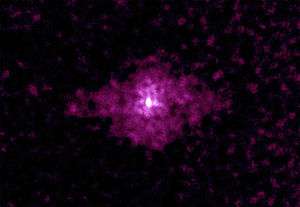SN 1181
First observed between August 4 and August 6, 1181, Chinese and Japanese astronomers recorded the supernova now known as SN 1181 in eight separate texts. One of only eight supernovae in the Milky Way observable with the naked eye in recorded history, it appeared in the constellation Cassiopeia and was visible in the night sky for about 185 days.
 3C 58, a pulsar wind nebula, is the presumed remnant. | |
| Event type | Supernova |
|---|---|
| Spectral class | Unknown |
| Date | between 4 August and 6 August 1181 |
| Constellation | Cassiopeia |
| Right ascension | 2h 5m 38s[1] |
| Declination | +64° 49.7′[1] |
| Epoch | J2000 |
| Galactic coordinates | g.130.719+03.084[1] |
| Distance | >8kpc (~26,093 light-years) |
| Remnant | Unknown |
| Host | Milky Way |
| Progenitor | Unknown |
| Progenitor type | Unknown |
| Colour (B-V) | Unknown |
| Notable features | Visible at night for 185 days |
| Peak apparent magnitude | -1? |
| Preceded by | SN 1054 |
| Followed by | SN 1572 |
The radio and X-ray pulsar J0205+6449 (also known as 3C 58), which rotates about 15 times per second, is possibly the remnant from this event. If the supernova and pulsar are associated, the star is still rotating about as quickly as it did when it first formed.[2] This is in contrast to the Crab pulsar, known to be the remnant of the SN 1054 supernova in the year 1054, which has lost two-thirds of its rotational energy in essentially the same time span.[3] Recent radio surveys of 3C 58, however, indicate that this supernova remnant may be much older and thus not associated with SN 1181.[4]
References
- "SN 1181". SIMBAD. Centre de données astronomiques de Strasbourg. Retrieved 2013-11-05.
- Panagia, N.; Weiler, K. W. (1980). "The absolute magnitude and the type classification of SN 1181 equals 3 C 58". Astronomy and Astrophysics. 82 (3): 389–391. Bibcode:1980A&A....82..389P.
- Galas, C. M. F.; Tuohy, I. R.; Garmire, G. P. (1980). "Soft X-ray observations of the supernova remnants HB 3 and 3C 58". The Astrophysical Journal Letters. 236: L13–L16. Bibcode:1980ApJ...236L..13G. doi:10.1086/183188.
- Bietenholz, M. F. (2006). "Radio Images of 3C 58: Expansion and Motion of Its Wisp" (PDF). The Astrophysical Journal. 645 (2): 1180–1187. arXiv:astro-ph/0603197. Bibcode:2006ApJ...645.1180B. doi:10.1086/504584.